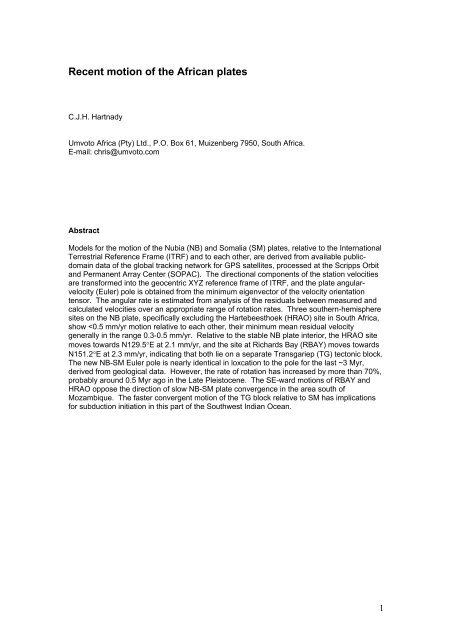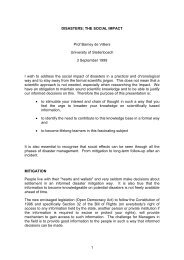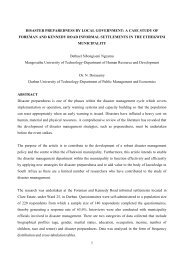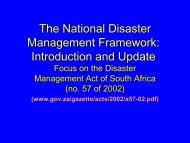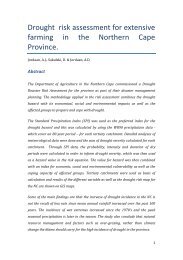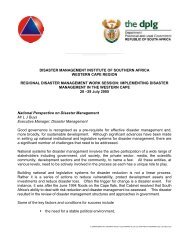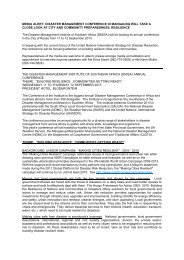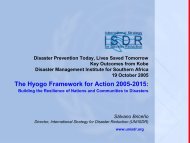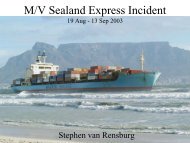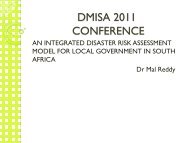Recent motion of the African plates - Disaster Management Institute ...
Recent motion of the African plates - Disaster Management Institute ...
Recent motion of the African plates - Disaster Management Institute ...
- No tags were found...
You also want an ePaper? Increase the reach of your titles
YUMPU automatically turns print PDFs into web optimized ePapers that Google loves.
<strong>Recent</strong> <strong>motion</strong> <strong>of</strong> <strong>the</strong> <strong>African</strong> <strong>plates</strong>C.J.H. HartnadyUmvoto Africa (Pty) Ltd., P.O. Box 61, Muizenberg 7950, South Africa.E-mail: chris@umvoto.comAbstractModels for <strong>the</strong> <strong>motion</strong> <strong>of</strong> <strong>the</strong> Nubia (NB) and Somalia (SM) <strong>plates</strong>, relative to <strong>the</strong> InternationalTerrestrial Reference Frame (ITRF) and to each o<strong>the</strong>r, are derived from available publicdomaindata <strong>of</strong> <strong>the</strong> global tracking network for GPS satellites, processed at <strong>the</strong> Scripps Orbitand Permanent Array Center (SOPAC). The directional components <strong>of</strong> <strong>the</strong> station velocitiesare transformed into <strong>the</strong> geocentric XYZ reference frame <strong>of</strong> ITRF, and <strong>the</strong> plate angularvelocity(Euler) pole is obtained from <strong>the</strong> minimum eigenvector <strong>of</strong> <strong>the</strong> velocity orientationtensor. The angular rate is estimated from analysis <strong>of</strong> <strong>the</strong> residuals between measured andcalculated velocities over an appropriate range <strong>of</strong> rotation rates. Three sou<strong>the</strong>rn-hemispheresites on <strong>the</strong> NB plate, specifically excluding <strong>the</strong> Hartebeesthoek (HRAO) site in South Africa,show
In order to test whe<strong>the</strong>r <strong>the</strong> NB-SM boundary 11 has undergone a comparable changebetween <strong>the</strong> late Pliocene and <strong>the</strong> present day, as previously suspected on geological andgeophysical grounds, 9 I review <strong>the</strong> space-geodetic solutions 7,8 for <strong>the</strong> NB and SM <strong>plates</strong>,which are generally current to <strong>the</strong> year 2000, and update <strong>the</strong>m using newer velocity estimatesfor key <strong>African</strong> stations in <strong>the</strong> continuously recording GPS network, current to epoch2003.4151. The station velocity results (Table 1), which serve as input data to <strong>the</strong> revisedmodelling <strong>of</strong> NB and SM recent <strong>motion</strong>s, are expressed in <strong>the</strong> current International TerrestrialReference System (ITRS) <strong>of</strong> <strong>the</strong> International Earth Rotation Service (IERS).Reference FramesThe quantitative analysis <strong>of</strong> <strong>the</strong> velocity field requires <strong>the</strong> definition <strong>of</strong> a reference frame formapping velocities that is meaningful for tectonic interpretation. 12 In particular, velocitieswithin an area <strong>of</strong> active deformation must be expressed in a regional reference frame thatbehaves more rigidly than <strong>the</strong> area under study. In <strong>the</strong> case <strong>of</strong> <strong>the</strong> better-covered EU plate,<strong>the</strong> accuracy <strong>of</strong> <strong>the</strong> NUVEL-1A plate model 2 is not sufficiently accurate to ensure anunbiased definition for rigid <strong>plates</strong> at <strong>the</strong> 2-3 mm/yr level 12 . The quantitative separation <strong>of</strong><strong>motion</strong> between <strong>the</strong> <strong>African</strong> <strong>plates</strong> is only recently achieved in <strong>the</strong> NUVEL-1A context 5 .Moreover, <strong>the</strong> NB-SM Euler pole is located within <strong>the</strong> wide plate boundary, so that <strong>the</strong> relativevelocity between <strong>the</strong> <strong>plates</strong> may locally be much less than 2 mm/yr, which makes <strong>the</strong>definition <strong>of</strong> a regional “stable reference frame” more problematic.The year 2000 realization <strong>of</strong> ITRS (ITRF2000) is a global multi-technique geodetic solution 13-14 that provides accurate position and velocities at about 500 globally distributed control sites,and an accurate estimation <strong>of</strong> relative <strong>motion</strong>s for 6 major tectonic <strong>plates</strong>. Five spacegeodetictechniques contribute to <strong>the</strong> ITRF: Very Long Baseline Interferometry (VLBI), LunarLaser Ranging (LLR), Satellite Laser Ranging (SLR), Global Positioning System (GPS), andDoppler Orbitography Radiopositioning Integrated by Satellite (DORIS). VLBI, LLR and SLRsolutions in ITRF benefit from ~20 years <strong>of</strong> measurement. GPS and DORIS solutions include2-10 years <strong>of</strong> continuous recording.In global tectonics, <strong>the</strong> condition <strong>of</strong> “no net rotation” (NNR) <strong>of</strong> <strong>the</strong> entire rigid lithosphere isused to define an “absolute” reference frame 15 , within which <strong>the</strong> geophysical model NNR-NUVEL-1A 2 describes <strong>the</strong> angular velocities <strong>of</strong> all <strong>plates</strong>. The ITRS also specifies a NNRcondition, aligning <strong>the</strong> orientation-time evolution <strong>of</strong> <strong>the</strong> ITRF2000 by a consistent geodeticmethod that minimizes <strong>the</strong> global rotation rate between ITRF2000 and NNR-NUVEL-1A 16 .3
MethodsThe present study is based on GPS data only for 8 <strong>African</strong>-region sites (Table 1 andFigure 1), provided through <strong>the</strong> Scripps Orbit and Permanent Array Center (SOPAC) in <strong>the</strong>University <strong>of</strong> California at San Diego. GPS site coordinates, ITRF2000 velocities, and timeseries are created at SOPAC by a “refined model” 17 that takes into account <strong>of</strong>fsets (coseismicor o<strong>the</strong>rwise), linear velocity, and annual and semi-annual fluctuations (for stationsthat have at least two years and one year <strong>of</strong> data, respectively). The daily processed sitepositions calculated using <strong>the</strong> GAMIT and GLOBK s<strong>of</strong>tware packages (http://wwwgpsg.mit.edu/~simon/gtgk/)are data input to this model. SOPAC lists coordinates from <strong>the</strong>most recent weekly processing run, generated using data for that week only.SOPAC also provides GPS position time series for stations (e.g., Fig. 2) for which allparameters are estimated with full white noise + flicker noise covariance based on a noiseanalysis. Parameter uncertainties are considered to be realistic estimates. For most stationsa process <strong>of</strong> regional filtering is carried out in <strong>the</strong> space domain. By stacking <strong>the</strong> time seriesfrom a group <strong>of</strong> “core sites”, a series containing common noises for <strong>the</strong> region is derived,which is <strong>the</strong>n subtracted from individual time series to improve positional estimates.The time-series for <strong>the</strong> station at <strong>the</strong> Hartebeesthoek Radio-astronomy Observatory (HRAO)in South Africa illustrates <strong>the</strong> derivation <strong>of</strong> <strong>the</strong> ITRF2000 velocity components in <strong>the</strong> North,East and Vertical directions (Fig. 2). In this study, <strong>the</strong> directional component (unit vector) <strong>of</strong><strong>the</strong> resultant horizontal (N-E) station velocity (Table 1) is transformed into <strong>the</strong> geocentric XYZreference frame <strong>of</strong> ITRF. In a graphical illustration (Fig. 3) <strong>of</strong> this procedure for <strong>the</strong> South<strong>African</strong> site at Su<strong>the</strong>rland (SUTH), <strong>the</strong> horizontal directional (large open square) lies in ageocentred plane (represented by <strong>the</strong> thin-dashed great circle in a lower or sou<strong>the</strong>rnhemisphere stereographic projection) normal to <strong>the</strong> pole through <strong>the</strong> SUTH site (small solidsquare).For two or more sites on a rigid plate <strong>of</strong> lithosphere, a plate angular-velocity (Euler) pole canbe obtained graphically by constructing a great circle through <strong>the</strong> coordinate-transformedvelocity vectors (solid great circles in top part <strong>of</strong> Figs. 3 and 4), and finding <strong>the</strong> pole normal tothat plane (circled solid dots or target symbols in top part <strong>of</strong> Figs. 3 and 4). This technique iscommon in structural geology for defining <strong>the</strong> best-fitting cylindrical fold axis from polesnormal to bedding planes, <strong>the</strong> “pi-circle method” 18 . In formal vector-statistical terms it isobtained numerically from <strong>the</strong> minimum eigenvector <strong>of</strong> <strong>the</strong> Scheidegger-Watson orientationtensor 19-20 .After prior solution for <strong>the</strong> Euler pole position by <strong>the</strong> above-mentioned numerical method, anangular rate <strong>of</strong> rotation is estimated from analysis <strong>of</strong> <strong>the</strong> residuals between measured and4
calculated velocities over a small range <strong>of</strong> possible rotation rates (bottom sections <strong>of</strong> Figs. 3and 4).ResultsThe NB-ITRF200, SM-ITRF2000 absolute and <strong>the</strong> NB-SM relative angular velocities aretabulated (Table 2, boldface entries) along with o<strong>the</strong>r recent estimates <strong>of</strong> <strong>the</strong>se plate-<strong>motion</strong>parameters 5,7-8 , for purposes <strong>of</strong> comparison.Nubia Angular VelocityThe site location data (smaller solid symbols) and antipodal locations <strong>of</strong> <strong>the</strong> geocentred sitevelocity vectors (larger open symbols) are shown for SUTH (square), N’Koltang, Gabon(NKLG, triangle) and Gough Island (GOUG, diamond) in a lower, sou<strong>the</strong>rn hemispherestereographic projection (Fig. 3 upper). In <strong>the</strong> ITRF frame <strong>the</strong>se velocity directions aredistributed along a ~40° arc <strong>of</strong> a well defined great circle (solid line), with <strong>the</strong> NKLG andGOUG directions at <strong>the</strong> data limits <strong>of</strong> this arc. The antipode (49.9°S 96.2°E) <strong>of</strong> <strong>the</strong> NB-ITRF2000 Euler pole (large target symbol) is <strong>the</strong> minimum eigenvector or axis <strong>of</strong> leastmoment <strong>of</strong> inertia <strong>of</strong> <strong>the</strong> velocity vector distribution.The scalar rate <strong>of</strong> rotation is obtained by graphical analysis <strong>of</strong> <strong>the</strong> site residuals (opensymbols) and mean residual (solid circles) over <strong>the</strong> range <strong>of</strong> values 0.253-0.262 mm/yr (Fig. 3lower). The value preferred (0.258°/Myr), which is equal to that independently obtained byDeMets (pers. comm., 2002), is based on consideration <strong>of</strong> <strong>the</strong> least difference or deviationbetween site residuals and <strong>the</strong> mean, ra<strong>the</strong>r than on <strong>the</strong> minimum mean residual(0.29 mm/yr), which is obtained for a value <strong>of</strong> 0.256°/Myr (Fig. 3). This option gives moreweight to <strong>the</strong> GOUG datum than to NKLG, which may be justified by <strong>the</strong> longer GPS timeseries for <strong>the</strong> former (Table 2).Somalia Angular VelocityThe site location data (smaller solid symbols) and antipodal locations <strong>of</strong> <strong>the</strong> geocentred sitevelocity vectors (larger open symbols) are shown for Malindi, Kenya (MALI, square), and LaMisere, Seychelles (SEY1, diamond) in a sou<strong>the</strong>rn hemisphere stereogram (Fig. 4 upper). Asonly two directions are involved, <strong>the</strong> antipode (45.7°S 69.9°E) <strong>of</strong> <strong>the</strong> SM-ITRF2000 Euler pole(large target symbol) is in this case equivalent to a simple vector cross-product <strong>of</strong> <strong>the</strong> MALIand SEY1 unit vectors, which are separated by a ~20° angle <strong>of</strong> arc on <strong>the</strong> common greatcircle (solid line).The scalar rate <strong>of</strong> rotation is obtained by graphical analysis <strong>of</strong> <strong>the</strong> site residuals (opensymbols) and mean residual (solid circles) over <strong>the</strong> range <strong>of</strong> values 0.33-0.41 mm/yr (Fig. 45
lower). Likewise to <strong>the</strong> NB case, <strong>the</strong> value preferred (0.37°/Myr) is based on <strong>the</strong> leastdifference between site residuals and <strong>the</strong>ir mean, ra<strong>the</strong>r than on <strong>the</strong> minimum mean residual,which is obtained for a value <strong>of</strong> 0.35 mm/yr.Nubia-Somalia Relative MotionThe NB-SM relative angular velocity, with an Euler pole close to 27°S 36°E (Table 2), isobtained by vector addition <strong>of</strong> <strong>the</strong> NB-ITRF2000 and ITRF2000-SM angular velocities.DiscussionThe velocity vector diagram is a useful tool for graphical representation <strong>of</strong> plate <strong>motion</strong>s at aparticular site, whe<strong>the</strong>r observed or modelled, relative or absolute. Its original and mostfrequent application in plate tectonics is in <strong>the</strong> analysis <strong>of</strong> velocity closure around, and <strong>the</strong>kinematic stability <strong>of</strong>, triple junctions between <strong>the</strong> major <strong>plates</strong>. 21Diagrams (Figs. 5-7) <strong>of</strong> <strong>the</strong> measured absolute-velocity vector, i.e., with ITRF2000 as <strong>the</strong>coordinate origin <strong>of</strong> <strong>the</strong> North velocity (Vn) and East velocity (Ve) axes, are presented for all<strong>of</strong> <strong>the</strong> sites listed in Table 1. In each <strong>of</strong> <strong>the</strong>se diagrams, <strong>the</strong> thicker solid line from <strong>the</strong> origin(not shown in <strong>the</strong> enlargement) to <strong>the</strong> centre <strong>of</strong> <strong>the</strong> 1-σ error bars, is <strong>the</strong> GPS velocitymeasurement. O<strong>the</strong>r solid or dashed lines, drawn from <strong>the</strong> (out-<strong>of</strong>-frame) origin to varioussymbols, represent model plate (NB or SM) velocities in ITRF2000. The direction and amount<strong>of</strong> <strong>the</strong> residual, i.e., <strong>the</strong> difference vector between model and observation, is easily seen andevaluated in <strong>the</strong>se graphs.Stable NB Reference FrameThe velocities <strong>of</strong> <strong>the</strong> four western sites (SUTH, NKLG, GOUG and MAS1 in Fig. 1) are usedto constrain <strong>the</strong> present-day <strong>motion</strong> <strong>of</strong> NB (Fig. 3 and Fig. 5). In <strong>the</strong> previous GPS-basedanalysis, 8 <strong>the</strong> sites SUTH and GOUG were used to calculate <strong>the</strong> NB angular velocity,toge<strong>the</strong>r with Maspalomas, Canary Isles (MAS*, composite <strong>of</strong> sites MAS1 and MASP linkedby a published site tie) and also with HRAO and HAR* (Hartebeesthoek composite site). TheNKLG site was not yet available, having only been commissioned during 2000, <strong>the</strong> year towhich <strong>the</strong> earlier study was current. At this time, both SUTH and GOUG had records <strong>of</strong> about<strong>the</strong> same duration as NKLG has for this study (~3 years).The NB angular-velocity model (Table 1) calculated from only SUTH, NKLG and GOUG(Fig. 3), provides a velocity fit that is within <strong>the</strong> 1-σ error limits <strong>of</strong> <strong>the</strong>se three sites (Fig. 5).For both SUTH and NKLG, <strong>the</strong> new NB-ITRF2000 model shows a very slight counterclockwisebias in direction (upper panels in Fig. 5), and for NKLG a slight overestimate in6
speed (upper right in Fig. 5). For GOUG, <strong>the</strong> model’s directional fit is close to perfect (lowerleft in Fig. 5), but <strong>the</strong> speed is underestimated.The NB-ITRF97 angular-velocity model <strong>of</strong> Sella et al. 8 predicts velocity vectors for SUTH,NKLG and GOUG that are rotated a few degrees clockwise from <strong>the</strong> observed velocity, andlie outside <strong>the</strong> 1-σ error limits for Vn, especially in <strong>the</strong> case <strong>of</strong> GOUG (Fig. 5). It provides a fitto <strong>the</strong> data from MAS1 (lower right in Fig. 5) that is no better than <strong>the</strong> NB-ITRF2000 result,having a clockwise bias <strong>of</strong> about <strong>the</strong> same amount as <strong>the</strong> counter-clockwise bias <strong>of</strong> <strong>the</strong> latter.However, <strong>the</strong> Canary Isles are a neovolcanic massif <strong>of</strong> probable hotspot origins, extendinginto <strong>the</strong> Atlantic Ocean from <strong>the</strong> direction <strong>of</strong> <strong>the</strong> neotectonically active High Atlas and AntiAtlas mountains <strong>of</strong> Morocco. Some question may <strong>the</strong>refore arise as to whe<strong>the</strong>r MAS1 is reallylocated on a stable part <strong>of</strong> <strong>the</strong> NB plate, or alternatively lies within <strong>the</strong> zone <strong>of</strong> influence <strong>of</strong> <strong>the</strong>EU-NB plate boundary.A comparison <strong>of</strong> <strong>the</strong> MAS1 velocity with <strong>the</strong> model vectors derived from recent EU-ITRF96and EU-ITRF97 angular-velocity models, respectively <strong>of</strong> Zhang et al. 22 and Sella et al. 8 ,shows that <strong>the</strong> EU-ITRF96 prediction fits <strong>the</strong> MAS1 data closely, whereas <strong>the</strong> improved EU-ITRF97 model is quite different.The three sites used in <strong>the</strong> present NB-ITRF2000 solution are located around <strong>the</strong> continentalmargin <strong>of</strong> south-western Africa and an eastern South Atlantic core region <strong>of</strong> Early Cretaceousoceanic lithosphere within which little or no intraplate seismic activity is recorded (Fig. 1).Consequently <strong>the</strong>ir preferred status as a 3-site “A Priori Stable Nubia Reference Frame” orAPSNuRF, following <strong>the</strong> EU plate precedent <strong>of</strong> an 8-site APSERF, 12 is tectonicallyappropriate.Velocity <strong>of</strong> <strong>the</strong> SM plateThe present, minimal, 2-site solution for <strong>the</strong> angular velocity <strong>of</strong> <strong>the</strong> SM plate (Table 1)provides an exact directional fit to observed velocities (Fig. 6) at MALI and SEY1. However,MALI moves slower than <strong>the</strong> NB-ITRF2000 model prediction and SEY1 moves faster (solidsquare symbols in Fig. 6). In both cases <strong>the</strong> model solution lies outside <strong>the</strong> 1-σ error box onboth Vn and Ve.The REVEL model (SM-ITRF97; open square symbols) is also based on <strong>the</strong> data to year2000 from only MALI and SEY1, except that <strong>the</strong> first year <strong>of</strong> data (1995-6) from SEY1 wasomitted as being “particularly noisy” (ref. 8, p. 11-26). The REVEL model velocity for <strong>the</strong>longer MALI GPS time series is a closer fit than <strong>the</strong> new SM-ITRF2000 model (Table 1),although rotated some degrees clockwise from <strong>the</strong> data, being outside <strong>the</strong> 1-σ error for Vn7
1. A tectonically stable core region <strong>of</strong> <strong>the</strong> NB plate is defined around a triangle <strong>of</strong>sou<strong>the</strong>rn hemisphere GPS sites, with vertices at SUTH, NKLG and GOUG,covering <strong>the</strong> south-western part <strong>of</strong> <strong>the</strong> <strong>African</strong> continent and <strong>the</strong> eastern side <strong>of</strong><strong>the</strong> South Atlantic Ocean, within which NB plate rigidity is tightly bound below anupper limit <strong>of</strong> ~0.4 mm/yr;2. The NB-ITRF2000 Euler pole position defined on <strong>the</strong>se three sites correspondsclosely to o<strong>the</strong>r recent estimates, and <strong>the</strong> angular-velocity rate is within0.005°/Myr <strong>of</strong> <strong>the</strong> REVEL angular-velocity model for NB <strong>motion</strong>;3. The SM-ITRF2000 Euler pole, uniquely defined by velocity directionals (unitvectors) from only two sites (MALI and SEY1), differs substantially from o<strong>the</strong>rrecent estimates, and <strong>the</strong> poorly constrained angular-velocity rate is greatlyincreased over previous estimates; i.e., 0.37°/Myr versus 0.31°/Myr for <strong>the</strong>REVEL model <strong>of</strong> SM plate <strong>motion</strong>;4. The velocities <strong>of</strong> GPS sites HRAO and RBAY in <strong>the</strong> north-eastern part <strong>of</strong> SouthAfrica, diverge in a south-easterly direction by 2.1-2.3 mm/yr from a referenceframe attached to <strong>the</strong> rigid core <strong>of</strong> <strong>the</strong> NB plate. Because <strong>the</strong>se sites areseparated from stable NB by <strong>the</strong> neotectonically active arc between <strong>the</strong>Okavango Rift in Botswana and <strong>the</strong> Senqu Seismic Belt in South Africa andLesotho, <strong>the</strong>y are considered to lie on a separate Transgariep (TG) tectonicblock, or microplate;5. The new Euler pole <strong>of</strong> NB-SM relative <strong>motion</strong> coincides closely with <strong>the</strong> positionnear <strong>the</strong> Mozambique coastline, representative <strong>of</strong> NB-SM rotation over <strong>the</strong> past~3 Myr, as defined by geologically-based (seafloor-spreading rate and fracturezonetrend) data from NB and SM boundaries with o<strong>the</strong>r <strong>plates</strong> along <strong>the</strong>Southwest Indian Ridge, in <strong>the</strong> Gulf <strong>of</strong> Aden and <strong>the</strong> Red Sea;6. The greatly increased rate <strong>of</strong> NB-SM relative rotation dates from ~0.5 Ma, basedon a probable correlation with distinct Late Pleistocene changes in crustal-stressregime, volcanic history and tectonic evolution along <strong>the</strong> western boundary <strong>of</strong> <strong>the</strong>SM plate, in places as widely separated as <strong>the</strong> Kenya Rift and <strong>the</strong> submarineNatal Valley <strong>of</strong>fshore <strong>of</strong> South Africa.Acknowledgements. This research was supported by Umvoto Africa (Pty) Ltd as part <strong>of</strong>its <strong>African</strong> GeoRisk Provention Strategy, and would not have been possible without <strong>the</strong>scientific efforts in <strong>the</strong> global “public good” <strong>of</strong> UCSD’s SOPAC.12
16. Altamimi Z., Sillard P. and Boucher C. (2003). The Impact <strong>of</strong> a No-Net-RotationCondition on ITRF2000. Geophys. Res. Lett. 30(2), doi:10.1029/2002GL016279.17. Nikolaidis R. (2002). Observation <strong>of</strong> Geodetic and Seismic Deformation with <strong>the</strong>Global Positioning System, Ph.D. Thesis, University <strong>of</strong> California, San Diego, ??? pp..18. Ramsay J.G. (1967). Folding and Fracturing <strong>of</strong> Rocks. McGraw-Hill, New York,568 pp.19. Scheidegger A.E. (1965). On <strong>the</strong> statistics <strong>of</strong> <strong>the</strong> orientation <strong>of</strong> bedding planes, grainaxes, and similar sedimentological data. U.S. Geol. Survey Pr<strong>of</strong>. Paper 525-C, 164-167.20. Watson G.S. (1965). Equatorial distributions on a sphere. Biometrika 52, 193-203.21. McKenzie D.P. and Morgan W.J. (1969). Evolution <strong>of</strong> triple junctions. Nature 224,125-133.22. Zhang Z., Zhu W. and Xiong Y. (1999) Global plate <strong>motion</strong> models incorporating <strong>the</strong>velocity field <strong>of</strong> ITRF96. Geophys. Res. Lett.26, 2813-2816.23. Incorporated Research Institutions for Seismology (2003). Global SeismographicNetwork station list (Online at web-site http://iris.synapse.ru/GSN/GSNstations.htm)24. Ma C. and Ryan J. W. (1998). NASA Space Geodesy Program -- GSFC DATAAnalysis -- 1998, VLBI Geodetic Results 1979-1998, NASA Report, August, 1998.(see http://www.hartrao.ac.za/geodesy/vlbi.gif).25. Modisi M.P., Atekwana E.A., Kampunzu A.B. and Ngwisanyi T.H. (2000). Riftkinematics during <strong>the</strong> incipient stages <strong>of</strong> continental extension: evidence from <strong>the</strong>nascent Okavango rift basin, northwest Botswana. Geology 28, 939-942.26. Korn H. and Martin H.M. (1952). The seismicity <strong>of</strong> South West Africa. Trans. Geol.Soc. S. Afr. 55, 85-88.27. Martin A.K. and Hartnady C.J.H. (1986). Plate tectonic development <strong>of</strong> <strong>the</strong> southwestIndian Ocean: a revised reconstruction <strong>of</strong> east Antarctica and Africa. J. Geophys.Res. 91, 4767-4786.28. Raillard S. (1990). Les marges de l'Afrique de l'Est et les zones de fractureassociées: Chaîne Davie et Ride du Mozambique - Campagne MD-60/MACAMO-II,Thesis, Université Pierre et Marie Curie, Paris, 272 pp.29. Bosworth W., Burke K. and Strecker M. (2000). Magma chamber elongation as anindicator <strong>of</strong> intraplate stress field orientation: "borehole break-out mechanism" andexamples from <strong>the</strong> Late Pleistocene to <strong>Recent</strong> Kenya Rift Valley. In: Stress, Strainand Structure, A volume in honour <strong>of</strong> W D. Means. Eds: M.W. Jessell and J.L.Urai.Volume 2, Journal <strong>of</strong> <strong>the</strong> Virtual Explorer.http://www.virtualexplorer.com.au/VEjournal/2000Volumes/Volume2/www/contribs/bosworth/index.html)30. Bosworth W. and Strecker M.R. (1997). Stress field changes in <strong>the</strong> Afro-Arabian riftsystem during <strong>the</strong> Miocene to <strong>Recent</strong> Period. Tectonophysics 278, 47-62.14
31. Chen M-T., Bertrand P., Balut Y., Schneider R., Rogers J. and Taiwan IMAGESparticipants (1998). IMAGES II cruise (NAUSICAA) explores Quaternary climaticvariability and linkage <strong>of</strong> Benguela and Agulhas Current Systems in <strong>the</strong> Sou<strong>the</strong>rnIndian-Atlantic ocean: Participation by consortium <strong>of</strong> Taiwan institutions (coordinatedby National Taiwan University). J. Geol. Soc. China 41: 73-80.32. Niemi T. M., Ben-Avraham Z., Hartnady C.J.H. and Reznikov M. (2000). Post-Eocene seismic stratigraphy <strong>of</strong> <strong>the</strong> deep ocean basin adjacent to <strong>the</strong> sou<strong>the</strong>ast<strong>African</strong> continental margin: A record geostrophic bottom-current systems, MarineGeology 162, 237-258.33. Hartnady C.J.H. (1990). Seismicity and plate boundary evolution in sou<strong>the</strong>asternAfrica. S. Afr. J. Geol. 93, 473-484.34. Triep E.G. and Sykes L.R. (1997). Frequency <strong>of</strong> occurrence <strong>of</strong> moderate to greatearthquakes in intracontinental regions. J. geophys. Res. 102, 9923-9948.35. SOPAC .. http://sopac.ucsd.edu/cgi-bin/refinedTimeseriesListing.cgi15
TABLESTable 1. Site Positions and Velocities relative to ITRF2000Position Velocity Time seriesSite°Ν °Ε North East Vertical Start EndNubia plateMAS1 27.764 -15.633 16.43 ± 0.26 16.13 ± 0.47 1.80 ± 1.16 1994.4260 2003.4151NKLG 0.354 9.672 18.12 ± 0.67 21.79 ± 1.45 -2.12 ± 2.19 2000.2500 2003.4151SUTH -32.380 20.810 17.61 ± 0.65 15.92 ± 0.86 2.90 ± 1.30 1998.2890 2003.4151GOUG -40.349 -9.881 18.03 ± 0.62 20.26 ± 1.17 -10.79 ± 1.95 1998.6205 2003.4151Somalia plateMALI -2.996 40.194 13.51 ± 0.45 26.41 ± 1.16 1.67 ± 1.60 1995.8808 2003.4151SEY1 -4.674 55.479 7.67 ± 0.65 29.12 ± 1.53 0.00 ± 2.32 1995.3795 2002.5767Transgariep blockHRAO -25.890 27.687 15.88 ± 0.41 18.38 ± 0.66 -0.06 ± 0.93 1996.7418 2003.4151RBAY -28.796 32.078 14.64 ± 0.73 16.43 ± 0.71 5.70 ± 1.62 2000.8019 2003.4151Table 2.PlatePlate angular velocity solutions in <strong>the</strong> NB-SM systemPlate angular velocityReference frameLat Long. Rate°N °E °/Myr ccwSourceNB ITRF2000 49.9 276.2 0.258 This studyNB ITRF97 52.25 279.82 0.253 Sella, Dixon & Mao (2002) 8NB ITRF2000 49.8 278.7 0.258 C DeMets, pers. comm. (2002)NB NNR 54.5 273.8 0.280 Kreemer & Holt (2001) 7NB(AF) NNR (3 Ma) 50.65 285.92 0.291 DeMets et al. (1994) 2SM ITRF2000 45.7 249.9 0.37 This studySM ITRF97 53.51 258.45 0.31 Sella, Dixon & Mao (2002) 8SM ITRF2000 51.9 267 0.293 C DeMets, pers. comm. (2002)SM NNR 54.6 274.7 0.292 Kreemer & Holt (2001) 7NB SM -27.06 35.94 0.148 This studyNB SM -35.49 24.02 0.085 Sella, Dixon & Mao (2002) 8NB SM -41.34 24.75 0.051 C DeMets, pers. comm. (2002)NB SM -31 28 0.04 C Kreemer, pers. comm. (2002)NB SM -54.98 295.93 0.012 Kreemer & Holt (2001) 7NB SM -27.3 36.2 0.089 Chu & Gordon (1999) 5 16
FIGURE CAPTIONSFig. 1. GPS sites (labeled diamond symbols) around <strong>the</strong> Nubia (NB) – Somalia (SM) plateboundary in Africa. Stippled lines mark belts <strong>of</strong> more intense seismicity around smallerUkerewe Nyanza (UN), Rovuma (RV), Transgariep (TG) and possible Lwandle (LW?) tectonicblocks (after ref. 11). Epicentres (black dot symbols) are from <strong>the</strong> intracontinental earthquakecatalogue <strong>of</strong> Triep and Sykes 32 .Fig. 2. Times-series plot <strong>of</strong> North, East and Vertical components <strong>of</strong> position for <strong>the</strong>Hartebeesthoek (HRAO) GPS site during <strong>the</strong> 6.73–year period between 1996.7418 and2003.4151. The daily data (from server at http://sopac.ucsd.edu/cgibin/refinedTimeseriesListing.cgi)is fitted by a refined model (grey/red line) that incorporates alinear slope, representing plate-tectonic rotation, and annual and semi-annual periodicities,representing site fluctuations related to hydroclimatic or o<strong>the</strong>r transient factors.Fig. 3. Graphical solution from three sites for <strong>the</strong> NB plate angular velocity in <strong>the</strong> ITRF2000reference frame.(a) Lower hemisphere, equal angle stereogram centred on South pole, 0°E on equator attop. Solid black symbols are sou<strong>the</strong>rn hemisphere GPS sites: NKLG (triangle), SUTH(square) and GOUG (diamond). Smaller open symbols are poles at 90° from GPSsites along longitudinal planes through geocentre. Larger open symbols aregeocentre-projected positions (antipodes) <strong>of</strong> <strong>the</strong> tangential (horizontal) velocityvectors for each site, e.g., <strong>the</strong> angle between <strong>the</strong> large and small open squares,measured in <strong>the</strong> plane normal to <strong>the</strong> SUTH site vector (dashed great circle), is equalto <strong>the</strong> N42.1° E azimuth <strong>of</strong> <strong>the</strong> GPS-measured SUTH velocity vector. The best-fittingplane to <strong>the</strong> projected velocity vectors (solid great circle) is normal to <strong>the</strong> NB plateangular-velocity pole (large target symbol plotted at its sou<strong>the</strong>rn hemisphereantipode), and contains <strong>the</strong> maximum (solid circle) and intermediate (open circle)eigenvectors to <strong>the</strong> velocity orientation tensor.(b) Plot <strong>of</strong> site velocity residuals versus NB-ITRF2000 rotation rate about <strong>the</strong> NB angularvelocitypole in (a) above.Fig. 4. Graphical solution from two sites for <strong>the</strong> SM plate angular velocity in <strong>the</strong> ITRF2000reference frame.(a) Lower hemisphere, equal angle stereogram centred on South pole, 0°E on equator attop. Solid black symbols are sou<strong>the</strong>rn hemisphere GPS sites: MALI (square) andSEY1 (diamond). O<strong>the</strong>r symbols as in Fig. 3(a).(b) Plot <strong>of</strong> site velocity residuals (observed-model) versus SM-ITRF2000 rotation rateabout <strong>the</strong> SM angular-velocity pole in (a) above.Fig. 5. Velocity vector diagrams for four sites on <strong>the</strong> NB plate. Measured velocity vectorsfrom Table 1 (diamond symbol with standard error bars on thicker solid line to origin) arecompared with NB-ITRF2000 velocity model from Fig. 3 above (solid circle on thin solid line)and NB-ITRF97 velocity model from Sella et al. (2002; open circle on dashed line). For siteMAS1 (lower right block), not used in <strong>the</strong> present solution, additional comparison is made with<strong>the</strong> Eurasia (EU)-ITRF96 model from Nocquet et al. (2001).Fig. 6. Velocity vector diagrams for two sites on <strong>the</strong> SM plate. Measured velocity vectorsfrom Table 1 (diamond symbol with standard error bars on thicker solid line to origin) arecompared with SM-ITRF2000 velocity model from Fig. 4 above (solid square on thin solid line)and SM-ITRF97 velocity model from Sella et al. (2002; open square on dashed line).17
Fig. 7. Velocity vector diagrams for HRAO and RBAY sites on <strong>the</strong> Transgariep (TG) block.Measured velocity vectors from Table 1 (diamond symbol with standard error bars on thickersolid line to origin) are compared with NB- and SM-ITRF2000 velocity models from Figs. 3 & 4above (respectively solid square on thin solid, and solid circle on dash-dotted lines) and NBandSM-ITRF97 velocity models from Sella et al. (2002; respectively open square on thinsolid, and open circle on dashed lines).Fig. 8. NB-SM angular velocity poles (numbered ring symbols) in relation to <strong>the</strong> wide plateboundary zone and GPS sites (labelled diamond symbols) in Sou<strong>the</strong>rn and Eastern Africa.NB rotates anticlockwise relative to SM about <strong>the</strong> pole location. <strong>Recent</strong> <strong>motion</strong> pole (No. 1)from this study overlaps with <strong>the</strong> NUVEL1A-based (~3 Myr) solution <strong>of</strong> Chu & Gordon (1999;pole No. 5). O<strong>the</strong>r poles are from Sella et al. (2002, pole No. 2), DeMets (2002, pole No. 3),and Kreemer (2002, pole No. 4). NB-SM poles far<strong>the</strong>r west or south (Table 2) are not shown.18
FIGURESFig.119
Fig. 220
Fig. 321
Fig. 422
Fig. 523
Fig. 624
Fig. 725
Fig. 826


